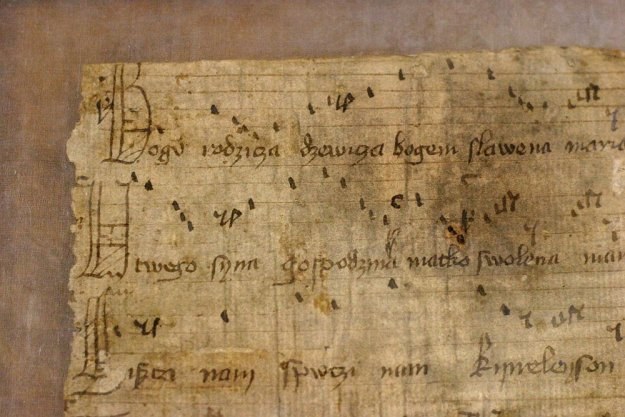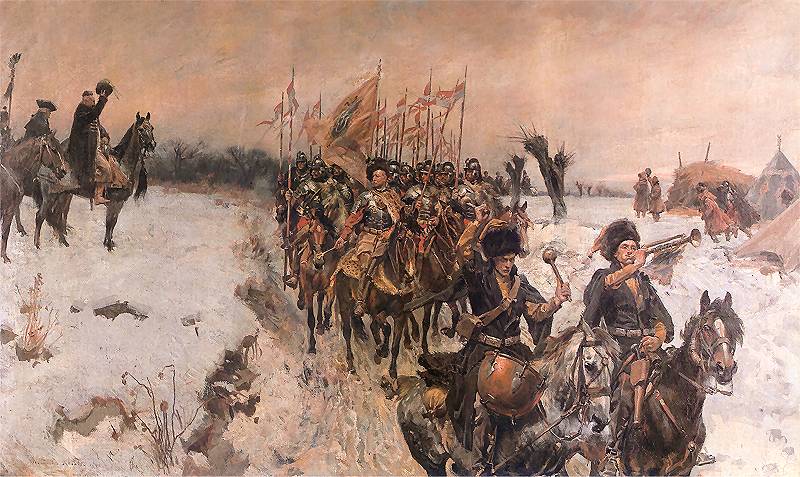Post by Bonobo on Jul 19, 2009 22:51:37 GMT 1
Bogurodzica (The Mother of God), is the oldest Polish religious hymn. It was composed somewhere between the 10th and 13th centuries. The origin of the song is not clear.
Polish knights sang it as an anthem before the Battle of Grunwald and during the battle with the Turkish army at Varna in 1444. Bogurodzica also accompanied the coronation ceremonies of the first Jagiellonian kings.
It was recorded in writing at the beginning of the 15th century. Two records preserved till today date back to that time:
1. the Kcynia record including two initial stanzas together with musical notation;
2. the Kraków record covering thirteen stanzas without notes.
Other records date back to the second half of the fifteenth century, the turn of the fifteenth and sixteenth centuries and to the beginning of the 16th century. In 1509 the song was printed in Kraków in Jan Łaski's Statut.
The origin of the song is not clear (the thesis about the authorship of St Adalbert has been rejected). It used to be related either to Latin liturgy, the tradition of church hymns, Greek or Old Church Slavonic influences, Western or Eastern culture. The two initial stanzas were created first - probably in the middle or at the end of the thirteenth century, or possibly at the very beginning of the fourteenth century.
Bogurodzica is a prayer hymn whose first stanza contains an invocation to Christ through the intercession of Mary. It begins with an apostrophe to her - to the Mother of Christ, the Virgin, praised by God, the chosen one. After the apostrophe, there is an appeal to Mary to win favour for people from her Son.
The second stanza begins with a direct addresses to Christ (called God's Son) - with an invocation to John the Baptist who can support human imploring. The prayer closing this stanza contains a request that Christ give people a blissful stay on earth and, after death, everlasting existence in heaven. The subsequent stanzas develop various motifs: Easter, the Passion, a litany - with invocations to the saints.
Bogurodzica was initially connected with the mass and procession but already in the fifteenth century it became a knight's hymn. Thanks to Jan Długosz (historian, author of Annales seu Cronicae incliti Regni Poloniae) we know that it was sung at Grunwald in 1410 as well as before other battles in subsequent years. It also accompanied the coronation ceremonies of Władysław Warneńczyk. That is why Długosz called Bogurodzica "carmen patrium" (the hymn of the motherland). In the next centuries the hymn lost its significance. It regained its position of "carmen patrium" in the nineteenth century and has held it to the present day.
en.wikipedia.org/wiki/Bogurodzica
Manuscript from 1400.
upload.wikimedia.org/wikipedia/commons/thumb/1/1c/Bogurodzica_rekopis1407.png/466px-Bogurodzica_rekopis1407.png
Old Polish English
Bogurodzica, dziewica, Bogiem sławiena Maryja, Mother of God, Virgin, by God glorified Mary,
Twego syna, Gospodzina, matko zwolena Maryja, From your son, our Lord, chosen mother, Mary!
Zyszczy nam, spuści nam. Win over for us, send to us.
Kyrieleison. Kyrie Eleison.
Twego dziela krzciciela, Bożyce, Son of God, for the sake of your Baptist,
Usłysz głosy, napełń myśli człowiecze. Hear our voices, fulfill man's intentions.
Słysz modlitwę, jąż nosimy, Hearken to the prayer that we offer,
A dać raczy, jegoż prosimy, And deign to give us what we ask for:
A na świecie zbożny pobyt, On earth, a pious sojourn,
Po żywocie rajski przebyt. After life, heavenly residence.
Kyrieleison.
Painting by Józef Brandt "Bogurodzica". (1909)
Polish-Lithuanian Commonwealth forces singing the Bogurodzica hymn before the battle.

Recording
staropolska.pl/download/Bogurodzica_(Mother_of_God).mp3
Sung at the battle at Grunwald, 4.10, by knights before the main charge
at 0:30
Germans sing their battle hymn Christ ist erstanden at 3:50
Polish knights sang it as an anthem before the Battle of Grunwald and during the battle with the Turkish army at Varna in 1444. Bogurodzica also accompanied the coronation ceremonies of the first Jagiellonian kings.
It was recorded in writing at the beginning of the 15th century. Two records preserved till today date back to that time:
1. the Kcynia record including two initial stanzas together with musical notation;
2. the Kraków record covering thirteen stanzas without notes.
Other records date back to the second half of the fifteenth century, the turn of the fifteenth and sixteenth centuries and to the beginning of the 16th century. In 1509 the song was printed in Kraków in Jan Łaski's Statut.
The origin of the song is not clear (the thesis about the authorship of St Adalbert has been rejected). It used to be related either to Latin liturgy, the tradition of church hymns, Greek or Old Church Slavonic influences, Western or Eastern culture. The two initial stanzas were created first - probably in the middle or at the end of the thirteenth century, or possibly at the very beginning of the fourteenth century.
Bogurodzica is a prayer hymn whose first stanza contains an invocation to Christ through the intercession of Mary. It begins with an apostrophe to her - to the Mother of Christ, the Virgin, praised by God, the chosen one. After the apostrophe, there is an appeal to Mary to win favour for people from her Son.
The second stanza begins with a direct addresses to Christ (called God's Son) - with an invocation to John the Baptist who can support human imploring. The prayer closing this stanza contains a request that Christ give people a blissful stay on earth and, after death, everlasting existence in heaven. The subsequent stanzas develop various motifs: Easter, the Passion, a litany - with invocations to the saints.
Bogurodzica was initially connected with the mass and procession but already in the fifteenth century it became a knight's hymn. Thanks to Jan Długosz (historian, author of Annales seu Cronicae incliti Regni Poloniae) we know that it was sung at Grunwald in 1410 as well as before other battles in subsequent years. It also accompanied the coronation ceremonies of Władysław Warneńczyk. That is why Długosz called Bogurodzica "carmen patrium" (the hymn of the motherland). In the next centuries the hymn lost its significance. It regained its position of "carmen patrium" in the nineteenth century and has held it to the present day.
en.wikipedia.org/wiki/Bogurodzica
Manuscript from 1400.
upload.wikimedia.org/wikipedia/commons/thumb/1/1c/Bogurodzica_rekopis1407.png/466px-Bogurodzica_rekopis1407.png
Old Polish English
Bogurodzica, dziewica, Bogiem sławiena Maryja, Mother of God, Virgin, by God glorified Mary,
Twego syna, Gospodzina, matko zwolena Maryja, From your son, our Lord, chosen mother, Mary!
Zyszczy nam, spuści nam. Win over for us, send to us.
Kyrieleison. Kyrie Eleison.
Twego dziela krzciciela, Bożyce, Son of God, for the sake of your Baptist,
Usłysz głosy, napełń myśli człowiecze. Hear our voices, fulfill man's intentions.
Słysz modlitwę, jąż nosimy, Hearken to the prayer that we offer,
A dać raczy, jegoż prosimy, And deign to give us what we ask for:
A na świecie zbożny pobyt, On earth, a pious sojourn,
Po żywocie rajski przebyt. After life, heavenly residence.
Kyrieleison.
Painting by Józef Brandt "Bogurodzica". (1909)
Polish-Lithuanian Commonwealth forces singing the Bogurodzica hymn before the battle.

Recording
staropolska.pl/download/Bogurodzica_(Mother_of_God).mp3
Sung at the battle at Grunwald, 4.10, by knights before the main charge
at 0:30
Germans sing their battle hymn Christ ist erstanden at 3:50











